APSC 100 Midterm Notes
Module 1: The Profession of Engineering
Engineering Specializations
Biomedical Engineering BME
lies at the intersection of engineering, biology, medicine, life sciences, computer sciences(computation), and mathematics.
Chemical / Biomedical Engineering CHBE
integrates mainly chemistry with biology, physics, and math
design and implement processes to change raw materials into vital everyday products
Civil Engineering
oversee the deign, construction, and maintenance of both human and naturally built environments
involved in earthquake, structural, transportation, and municipal infrastructure
Computer Engineering
design, test, and implement software and the hardware of devices and the integration of computers into larger systems
focuses on designing and integrating complete systems consisting of hardware and software elements
Electrical Engineering
apply physics and mathematics to design devices and systems involving electricity
focuses on aspects from electronic properties of microscopic devices to the generation and distribution of power in electric power grids
Engineering Physics
combines the practical aspects of engineering with a deeper theoretical foundation in physics and mathematics
blends the analytical rigor of a science degree with the practical training of an engineering degree
Environmental Engineering
primarily focus on improving and maintaining the quality of air, land, water, and living systems.
Geological Engineering
draw from a foundation in geology, geomechanics, hydrology, and environmental science to solve engineering projects on large-scale infrastructure, natural resources, or in environmental protection and remediation.
requires an understanding of the natural environment, and in particular soil, rock, and groundwater
Manufacturing Engineering
applies foundations in material science, computer science, and mechanics for the design, operation, and optimization of production processes, from beginning to end.
Materials Engineering
specializes in the design, manufacture, and evaluation of both everyday materials, and new highly engineered materials by applying physical and chemical processes
Mechanical Engineering
diverse field of engineering which applies a foundation in physics to focus on the design and development of mechanical systems
covers areas ranging from product design, energy, aerospace, robotics, biomedical, automobiles, manufacturing, and building systems
Mining Engineering
involves extracting and processing valuable resources from the earth
Integrated Engineering
focuses on cross-disciplinary engineering, often with an emphasis on design, to solve multidisciplinary problems and intersections between traditional disciplines
Becoming and Engineer
Obtain an undergraduate degree and apply to receive your Iron Ring
Acquire relevant work experience in the province or territory where you are seeking to be licensed, supervised by a professional engineer
Pass a professional practice examination that tests understanding of legal and ethical standards, and other related topics
Demonstrate good behaviour; any instance of academic misconduct, criminal offence, or unprofessional conduct under a professional regulatory organization, can lead to regulatory body’s to deny granting you a license
Receive your seal. The seal ensures that you are taking professional responsibility for the work you supervised or contributed to.
Module 2: The Engineering Design Process
Engineering Design
Engineering design is the process used to solve real-world, open-ended problems.
Novice designers tend to use trial and error, and to jump right into trying to solve a problem before carefully thinking about. High-level of risk.
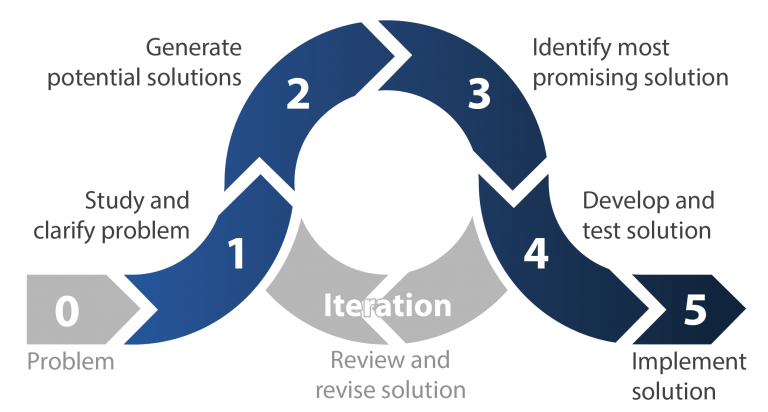 Stage 1: Study and Clarify Problem
Stage 1: Study and Clarify Problem
defining the problem to be solved, as well as learning about the problem context
identify the needs of stakeholders and converting these needs into precise specification the design will address
Stage 2: Generating Potential Solutions
concept generation; identify as many different solutions as possible
Stage 3: Identify Most Promising Solution
apply design specifications from the first stage to screen out possible solutions that do not meet requirements, and then to rank and score remaining ideas to identify the one solution
the design will invest their time and resources to develop.
Stage 4: Develop and Test Solution
analyze, refine, and develop the solution selected in the previous stage using engineering tools(prototypes, simulations, calculations), science and math, and consultations with stakeholders.
Stage 5: Implement Solution
involves the final constructions, communications, and delivery of the solution to the design problem.
Stage 6: Iteration
new ideas, perspectives, and information may come up which encourages or requires engineers to revisit and revise previous work
Why We Use The Design Process
Increases:
the chance of finding a solution in the time available
the quality of the final solution
the chance of completing the project on time
the chance of completing the project on budget
Cost: refers to money, effort, or other resources
Actual Costs: the cumulative total of money, effort, and resources we have spent up to a particular time as we complete the project
Costs committed: the sum of money, effort, and resources we have already spent plus those we will need to spend in the future based on our decisions to date
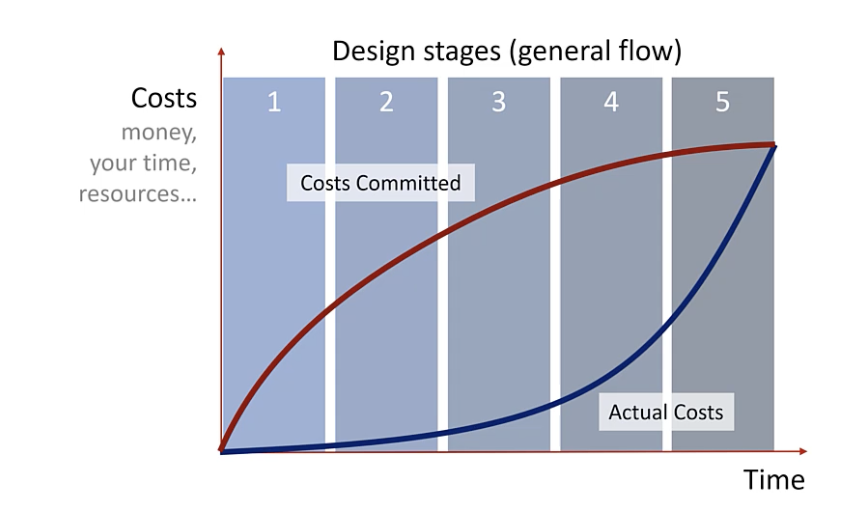
Costs committed > actual costs
Stage 1: Clarifying the Design Problems
Goal: have a precise definition of what makes a solution acceptable and what makes one viable solution better or worse than another.
Knowing the Stakeholders
Stakeholders: the people, groups, or organizations that are influenced by a project or can influence a project.
Salience: how prominent and important stakeholders are;
Power: refers to a stakeholder’s ability to influence a project; ex. a regulatory body or a group funding a project
Legitimacy: describes a stakeholder’s moral or legal right to have a say in the project; stakeholder groups impacted by a project generally have legitimacy; residents living next to a new waste treatment facility or users of a new product
Urgency: describes how critical or time sensitive a stakeholder perceives their needs in a project to be.
Tertiary Stakeholder: fulfills only one aspect of saliency
Secondary Stakeholder: fulfills two aspects of saliency
Primary Stakeholder: fulfills all three aspects of saliency
At the lowest level, ensure tertiary stakeholders are aware of the project, give them opportunities to speak up, and monitor what they are saying to help identify any changes in saliency
At the highest level, primary stakeholders often have decision-making input, and may even become collaborators on the project.

Identifying Stakeholder Needs
Needs: capture the wants and wishes of the stakeholders and the things that will increase (and decrease) stakeholder satisfaction; tend to be vague and subjective, making them difficult to apply directly in design decision-making.
Expressed needs: needs the stakeholders are aware of and freely share
Latent needs: needs that would please stakeholders but that they might not be aware of.
Threshold needs: needs stakeholders expect but might not think to mention
Target Design Specifications
Target design specifications: the combination of requirements and evaluation criteria that give unambiguous, objective criteria to apply in design decision-making.
The requirements establish the limits of acceptability for potential designs, whereas the evaluation criteria are used to distinguish otherwise acceptable design as satisfactory, good, and great.
Requirements: the collection of minimal thresholds our design must achieve and the qualities or features it must have (or not have) in order to be considered acceptable to stakeholders.
specific and quantifiable go/no go criteria
requirements come from stakeholder needs
Evaluation Criteria: the attributes of importance to stakeholders that determine satisfaction beyond a design that minimally meets all requirements.
evaluation criterion curve represents stakeholder satisfaction for a given attribute with 0% representing a minimally acceptable solution and 100% representing full satisfaction; can be linear or nonlinear, continuous or discrete
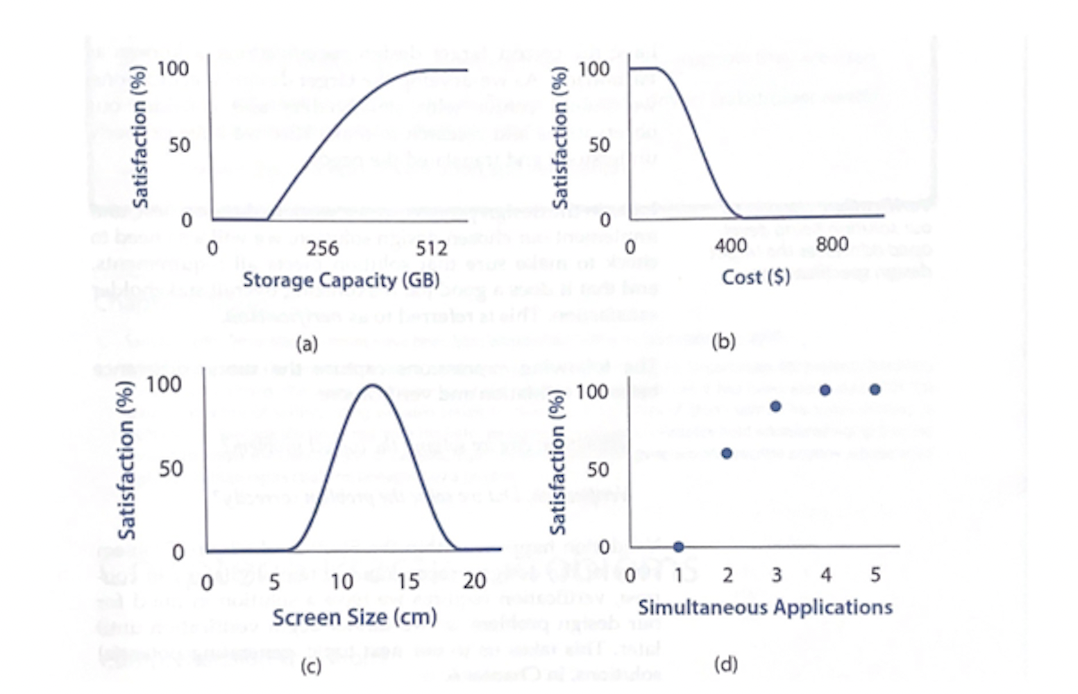
b) attributes like cost may have higher satisfaction for lower values of x
d) some attributes are discrete; ex, the number of application a device can run
Validation and Verification
Validation:
confirming the target design specifications we have set accurately match stakeholder needs
are we solving the correct problem?
happens in Study and clarify problem (and potentially later)
Verification:
checking if our solution being developed addresses the target design specifications
did we solve the problem correctly?
begins after we have a solution in mind, so stages following Identifying the most promising solution
Stage 2: Generating Potential Solutions
Goal: maximize the number and variety of potential solutions to our design problem.
Solution Space: the collection of all of the conceptual solutions we have identified.
During this stage, it is not just the number of concepts that matter, but variety between those concepts as well.
Principles of Concept Generation
it is important to have a clear understanding of the problem you are trying to solve before starting the concept generation process.
welcome ideas that challenge the rules; temporarily set aside the target design specification from stage 1
Focus on Quantity, Not Quality
Avoid Fixation (also called anchoring): a focus on one idea rather than thinking broadly, it should be avoided.
Welcome Unconventional Ideas
unconventional ideas can offer an innovative solution, or the inspiration for a different great idea, and should be encouraged
create a large variety of ideas, not just a large number
Do Not Evaluate Ideas
can be discouraging; inhibit open and free-flowing generation of ideas
Concept Generation Techniques
Brainstorming: a high energy approach to concept generation where ideas are quickly shared.
Pros: fun, quick,
Cons: most vocal members contribute most
C-Sketch: a structured form of brainstorming where each team member contributes in turn to each idea through sketching.
Pros:
relies on sketches which improves the quality of ideas,
sketches make it easier for others to interpret and build on ideas,
maximize concept variety by starting with one unique idea per teammate;
multiple starting points and equal time given to each idea combats fixation;
structured pace, without talking ensures each team member has equal voice and input
Stage 3: Identify the Most Promising Solution
Goal: identify the once conceptual solution that we will use as the basis for our final design. Quickly and efficiently moving from a large number of concepts to the one concept that has the most potential to succeed in the project.
Evaluation Framework
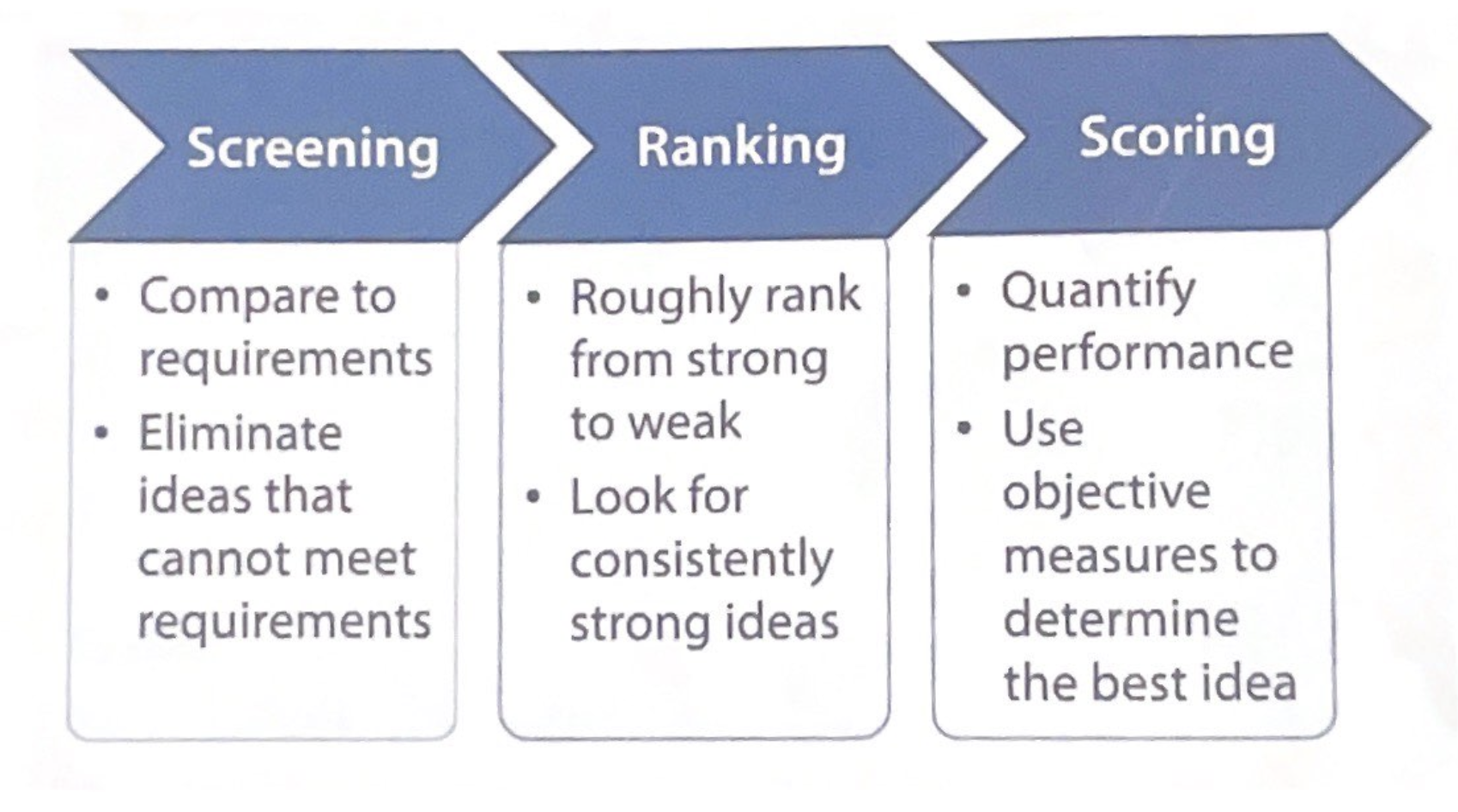
Screening: the process of removing any concepts that cannot be made to meet all requirements.
concepts that are screened out should be set aside, not discarded. In the event that a requirement changes, you may need to go back and repeat the screening process.
Ranking: the process of qualitatively comparing ideas in order to narrow down to a small number worth investigating further.
before removing an idea in ranking, a team should try to make it work better, or try to extract positive elements.
Methods:
Individual voting: each team member casts a set number of votes for the concept they believe best address the evaluation criteria.
Pairwise comparison: comparing each concept against every other concept, one at a time, trying to find the ones that are favoured most often. Favoured - 1, Tie - ½ Loss - 0
Criterion-based ranking: each concept is qualitatively evaluated using the evaluation criteria. A concept expected to perform better than average gains a point, below if less than average, 0 if average.
Scoring: a detailed and resource-intensive process to quantitatively evaluate a small number of ideas.
Methods:
Weighted Decision Matrix: a common tool used in scoring based on rating multiple options against each evaluation criterion with a weight applied.
Sensitivity Analysis: a process where weights and scores are adjusted in a WDM to assess the consistency of the results
Module 3: The Profession of Engineering
Prototyping
Prototype: a physical or virtual model that represents all or part of a design
Prototype Classification
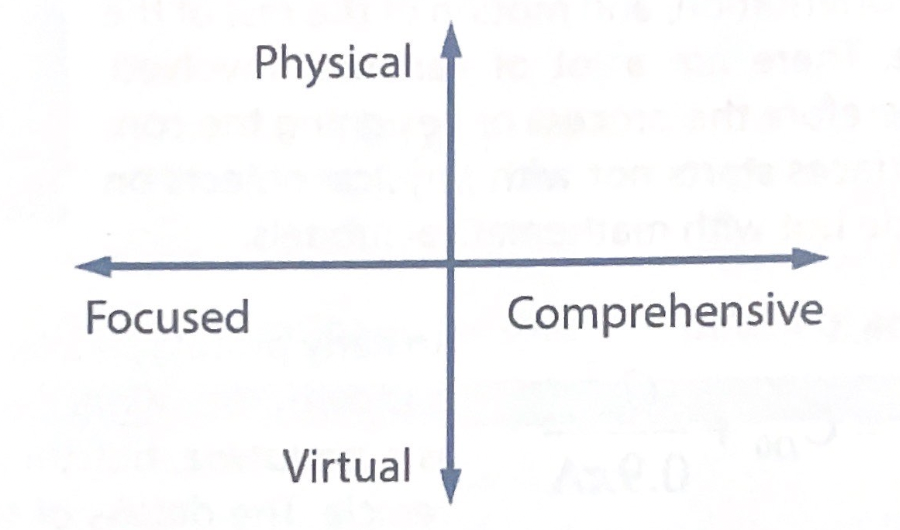 Focused Prototype: a prototype that represents only a limited number of elements of the final design
Focused Prototype: a prototype that represents only a limited number of elements of the final design
Comprehensive Prototype: a prototype that represents all elements of a final design
Physical Prototype: a prototype that physically exists in the same way as the final design
Virtual Prototype: a prototype that is not a full physical manifestation of the final design
Technical Communication
Communication
Audience: considerations of what the person or group your communication is directed to already known, needs to know, and wants to know
Purpose: your objectives and goals behind your communication; two purposes:
Inform: describe review, instruct, explain, demonstrate
Persuade: convince, influence, recommend, change, justify
Context: considerations for your communication including the format used, location, time, and other special factors.
Presentations
the title on a slide should be descriptive and reflect slide content
different font style or text colour can be used to highlight or differentiate information on a slide, but don’t let it be too distracting!
opt for high contrast between the text and background
beware of distracting elements (design, themes, other visual elements that do not add information)
Assertion-Evidence: states the key point and then supports that with data, visuals, and other evidence.
body language, eye contact, dress and behaviour are important in delivering an oral presentation.
Systems Thinking
Simple and Complex Systems
Deterministic: a problem or system free of randomness; the output for a given input will always be the same
Simple System: a system with a small number of elements and predictable behaviour (deterministic)
Complex System: a system with multiple interacting elements, randomness, and feedback (non-deterministic)
Considerations of Scale
Scale: the extent we are using to view a system, from small to large.
Spatial Scale: a scale based on the physical extent of a system.
Temporal Scale: a scale based on time, from now to the distant future
Organizational Scale: a scale based on organizational structures (such as with government), from local/municipal to international
Causal Loop Diagram
Causal Loop Diagram (CLD): a diagram of system consisting of variables (nodes) and feedback loops.
Reinforcing Loop: a feed-back loop in which an initial change in a variable is amplified through one cycle of the loop
Balancing Loop: a feedback loop in which one cycle of the loop counteracts (opposes) an initial change to one variable in the loop